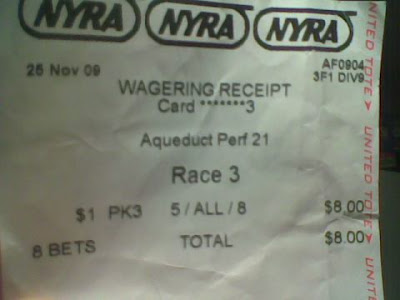While many fans of the sport have lamented the demise of dirt racing it seems that in places like New York dirt stakes racing has become an anachronism. The NYRA dirt stakes calender has become filled with short fields that are always at the mercy of weather. Up at Woodbine the stakes menu on the polytrack has flourished. Large competitive fields with shippers and little worry that weather will effect affect the races. Meanwhile at Aqueduct the weather played a major role in canceling the Stuyvesant. NYRA stakes coordinator Andrew Byrnes "“We decided today because we only had five entries and two or three of them said they were not going to run if it rained. The forecast calls for two inches (Nov. 14), so we didn’t want a field of two or three horses."
At Woodbine the Autumn Stakes attracted a competitive full field of main track and turf horses from coast to coast. Teide will ship in from the west coast, Sr. Henry from Keeneland, and Storm Caller from New York. Not one horse was to ship to New York for the canceled Stuyvesant. Woodbine is quickly eclipsing New York as the top east coast track for horsemen and horseplayers. The synthetic racing at Woodbine features large competitive fields that have generous returns. Competitive racing is the excitement that people look for when playing racing. While the horsemen have embraced synthetic racing, most American horseplayers still maintain an aversion to synthetic racing. The reliable speed horses, the mental shortcut speed figures and the quarterhorse "run and gun" style of running has lost the edge. Racing over the synthetic is fair racing. A poster who goes by"The Fatman" at paceadvantage outlines the aversion to synthetic track racing:
Those accustomed to SPEED BIASED DIRT TRACKS just can't come to grips with having to handle FAIR racing. There's more to racing than betting the speed. More to it than just looking at numbers, seeing who's fastest early and then just betting that horse. Well, at least that's the case when it comes to POLY. What I like about POLY is that the BEST horse has a chance in every race, no matter what the PACE. You can't say that about DIRT and you certainly couldn't say it about KEE and CALI, when they had those speed biased tracks.
The POLY HATERS can write whatever they want but it all comes down to not being able to handle the 'extra' that's necessary to win on these surfaces.
Almost forever the 'truism' was that SPEED usually wins. Not any more. The game is a bit more complicated than that on POLY.
While dirt racing in New York flounders, synthetic racing at Woodbine has blossomed. Synthetic surfaces may be the future, however in the breeding world synthetic surfaces have reawakened the past. The stamina breeding practices of past generations have have once again become the breeding ideal- while dirt speed breeding associated with breakdowns and distance challenged one-dimensional speed freaks has become the new anachronism. The horses, the prices and the future is in synthetic racing.

1 comment:
You make a well reasoned commentary on the future of the sport. I have thought for some time the Big A will get an all weather track as soon as VLTs rule the roost.
Post a Comment